KitchenAid WTW7600XW, WTW7800XW, WTW7300XW Installation Manual
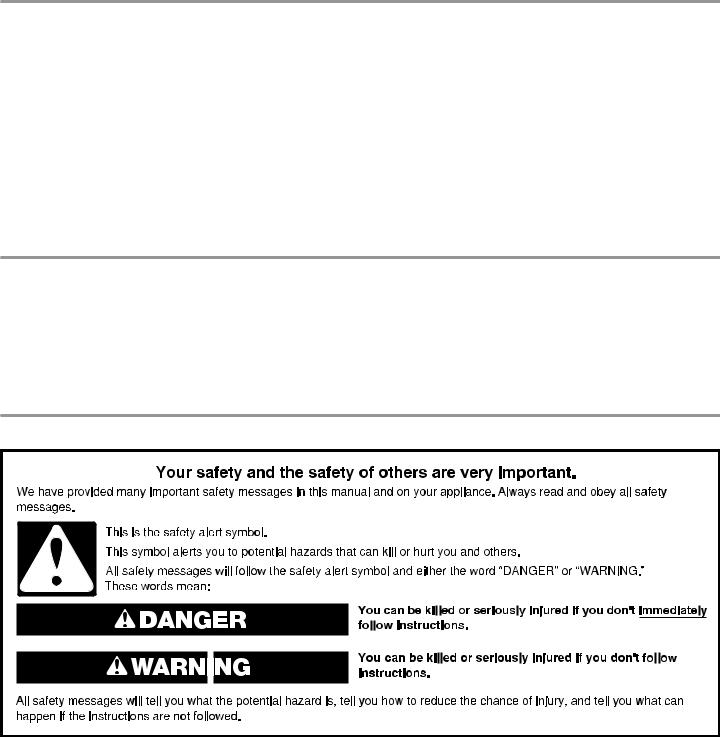
Washer Installation Instructions
Instructions d’installation de la laveuse
Table of Contents |
Table des matières |
|
WASHER SAFETY.............................................................. |
1 SÉCURITÉ DE LA LAVEUSE.............................................. |
9 |
INSTALLATION REQUIREMENTS.................................... |
2 |
Tools and Parts.................................................................... |
2 |
Location Requirements....................................................... |
3 |
Drain System........................................................................ |
4 |
Electrical Requirements...................................................... |
4 |
INSTALLATION INSTRUCTIONS...................................... |
5 |
Before you start: Remove shipping materials................... |
5 |
Connect Drain Hose............................................................ |
5 |
Connect Inlet Hoses............................................................ |
6 |
Level Washer........................................................................ |
7 |
COMPLETE INSTALLATION CHECKLIST........................ |
9 |
EXIGENCES D'INSTALLATION.......................................... |
9 |
Outillage et pièces................................................................ |
9 |
Exigences d'emplacement................................................. |
10 |
Système de vidange .......................................................... |
10 |
Spécifications électriques.................................................. |
11 |
INSTRUCTIONS D’INSTALLATION.................................. |
12 |
Avant de commencer : Retirer |
|
le matériel d’expédition...................................................... |
13 |
Raccordement du tuyau de vidange................................. |
14 |
Raccordement des tuyaux d’alimentation........................ |
14 |
Mise à niveau de la laveuse............................................... |
15 |
LISTE DE VÉRIFICATION |
|
POUR INSTALLATION TERMINÉE.................................. |
16 |
INSTALLATION NOTES |
NOTES CONCERNANT L'INSTALLATION |
Date of purchase:_________________________________ |
Date d'achat :_____________________________________ |
Date of installation:_ _______________________________ |
Date d'installation :_ ________________________________ |
Installer:_________________________________________ |
Installateur :_______________________________________ |
Model number:____________________________________ |
Numéro du modèle :_________________________________ |
Serial number:____________________________________ |
Numéro de série :___________________________________ |
Washer Safety
W10240438B
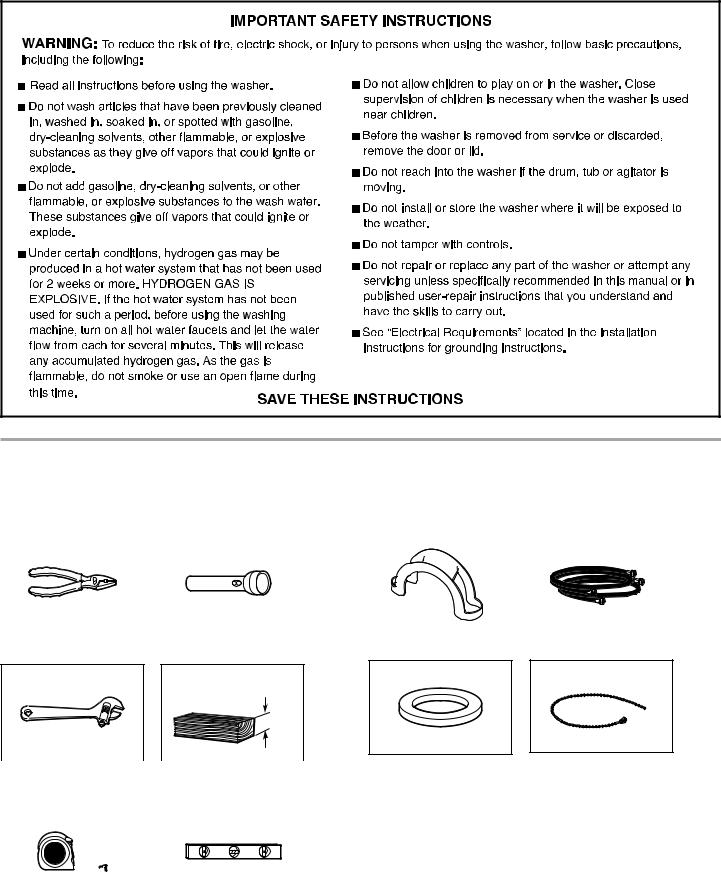
INSTALLATION REQUIREMENTS
TOOLS AND PARTS
Gather the required tools and parts before starting installation.
Tools needed: |
Parts supplied (located in the washer basket): |
|
|
|
|
|
|
|
|
|
|
|
|
|
|
|
Pliers that open to 1 9/16" |
|
Flashlight (optional) |
|
Drain hose form |
Water inlet hoses (2) |
|
(39.5 mm) |
|
|
|
|
|
|
4" min (102 mm)
|
|
|
|
|
|
|
Flat inlet hose washers (4) |
Removable Tie Strap |
Adjustable or open end |
|
Wood block |
||||||
wrench 9/16" (14 mm) |
|
|
|
|
||||
|
|
|
|
|
|
|
|
|
|
|
|
|
|
|
|
|
|
|
|
|
|
|
|
|
|
|
Tape measure or ruler |
Level |
2
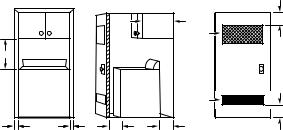
Alternate parts: (Not supplied with washer)
Your installation may require additional parts. To order, please refer to the phone number or website on the back page of your “Use and Care Guide”.
If you have: |
You will need: |
Laundry tub or |
Sump pump system (if not already |
standpipe taller |
available) |
than 96" (2.4 m) |
|
1" (25 mm) |
2" (50 mm) diameter to 1" (25 mm) |
diameter standpipe |
diameter Standpipe Adapter Kit, |
|
Part Number 3363920 and |
|
Connector Kit, Part Number 285835 |
Overhead sewer |
Standard 20 gal. (76 L) 39” (990 mm) |
|
tall drain tub or utility sink, sump |
|
pump, and connectors (available from |
|
local plumbing suppliers) |
Floor drain |
Siphon Break Kit, Part Number 285834 |
|
Drain Hose, Part Number 8318155 |
|
Connector Kit, Part Number 285835 |
Water faucets |
2 longer water fill hoses: |
beyond reach of |
6 ft. (1.8 m), Part Number 76314 |
fill hoses |
10 ft. (3.0 m), Part Number 350008 |
Lint clogged drain |
Drain protector, Part Number 376031 |
Spacing for recessed area or closet installation
All dimensions show recommended spacing allowed, with tested spacing of 0" (0 mm) clearance on sides.
■■ Additional spacing should be considered for ease of installation and servicing.
■■ Additional clearances might be required for wall, door, and floor moldings.
■■ Additional spacing should be considered on all sides of the washer to reduce noise transfer.
■■ For closet installation, with a door, minimum ventilation openings in the top and bottom of the door are required. Louvered doors with equivalent ventilitation openings are acceptable.
■■ Companion appliance spacing should also be considered.
|
|
|
|
14"*max. |
|
3"* |
|
|
|
|
|
|
(76 mm) |
||
|
|
|
|
(356mm) |
48 in.2* |
||
|
|
|
|
|
|||
17"* |
|
|
|
|
|
(310 cm2) |
|
|
|
|
|
|
|
|
|
(432 mm) |
|
|
|
|
|
|
|
|
|
|
|
|
|
24 in.2* |
|
|
|
|
|
|
|
(155 cm2) |
3"* |
|
|
|
|
|
|
|
|
1" |
27 1/2" |
1" |
1" |
27" |
5"* |
|
(76 mm) |
(25 mm) |
(699 mm) |
(25 mm)(25 mm)(686 mm) (127 mm) |
|
||||
LOCATION REQUIREMENTS
Select proper location for your washer to improve performance and minimize noise and possible “washer walk”. Install your washer in a basement, laundry room, closet, or recessed area.
Proper installation is your responsibility.
You will need:
■■ A water heater set to deliver 120°F (49°C) water to the washer.
■■ A grounded electrical outlet located within 4 ft. (1.2 m) of where the power cord is attached to the back of the washer. See “Electrical Requirements”.
■■ Hot and cold water faucets located within 3 ft. (900 mm) of the hot and cold water fill valves, and water pressure of 200 psi (138-690 kPa) for best performance.
■■ Level floor with maximum slope of 1" (25 mm) under entire washer. Installing the washer on carpet is not recommended.
■■ A sturdy floor to support the washer weight (washer, water, and load) of 315 lbs (143 kg).
IMPORTANT: Do not operate, install, or store washer where it will be exposed to water, weather, or at temperatures below 32° F (0° C). Some water can remain in washer and can cause damage in low temperatures. See your “Use and Care Guide” for information on winterizing.
Front view |
Side view |
Closet door |
|
|
with vents |
* Required spacing
3
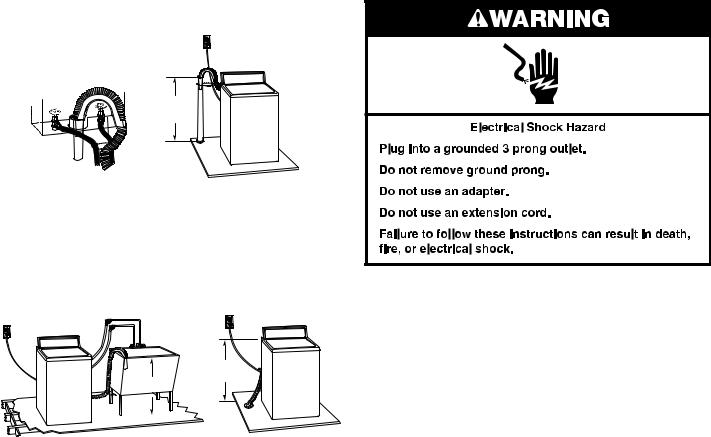
DRAIN SYSTEM
Drain system can be installed using a floor drain, wall standpipe, floor standpipe, or laundry tub. Select method you need.
39" (990 mm)
Wall standpipe |
Floor standpipe |
The standpipe drain requires a minimum diameter standpipe
of 2" (51 mm). The minimum carry-away capacity can be no less than 17 gal. (64 L) per minute. A 2" (51 mm) diameter to 1" (25 mm) diameter standpipe adapter kit is available. See “Tools and Parts”.
The top of the standpipe must be at least 39" (990 mm) high and no higher than 96" (2.4 m) from the bottom of the washer.
28" 39" (710 mm)
(990 mm)
Laundry Tub |
Floor |
The laundry tub drain system needs a minimum 20 gal. (76 L) capacity laundry tub. The top of the laundry tub must be at least 39" (990 mm) above the floor and no higher than 96" (2.4 m) from the bottom of the washer.
The floor drain system requires a siphon break that may
be purchased separately. See “Tools and Parts”. The siphon break must be a minimum of 28" (710 mm) from the bottom of the washer. Additional hoses might be needed.
ELECTRICAL REQUIREMENTS
■■ A 120 volt, 60 Hz., AC only, 15or 20-amp, fused electrical supply is required. A time-delay fuse or circuit breaker on
a separate circuit serving only this washer is recommended.
■■ This washer is equipped with a power supply cord having a 3 prong grounding plug.
■■ To minimize possible shock hazard, the cord must be plugged into a mating, 3 prong, grounding-type outlet, grounded in accordance with local codes and ordinances. If a mating outlet is not available, it is the personal responsibility and obligation of the customer to have the properly grounded outlet installed by a qualified electrician.
■■ If codes permit and a separate ground wire is used, it is recommended that a qualified electrician determine that the ground path is adequate.
■■ Do not ground to a gas pipe.
■■ Check with a qualified electrician if you are not sure the washer is properly grounded.
■■ Do not have a fuse in the neutral or ground circuit.
4
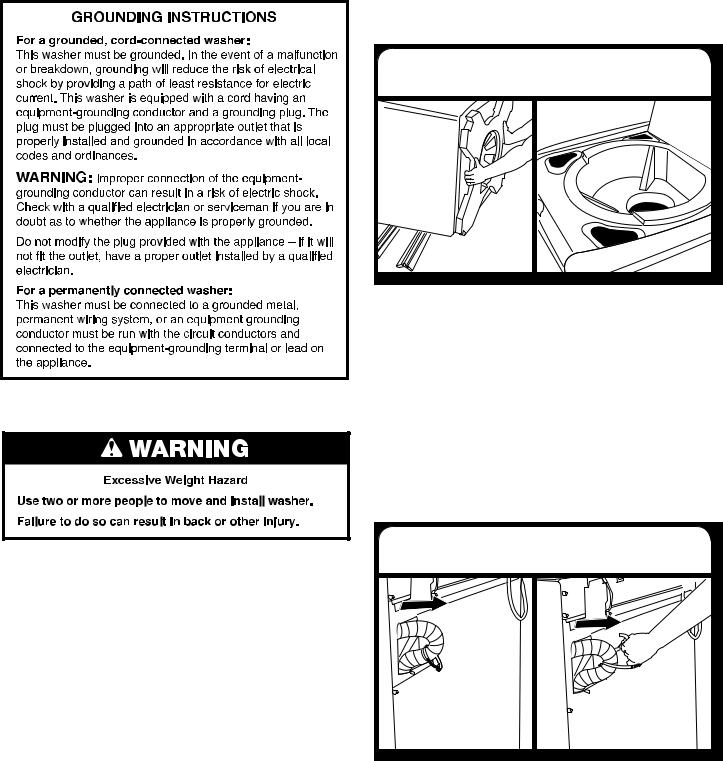
REMOVE SHIPPING BASE AND PACKING RING
1. Remove shipping base and packing ring
INSTALLATION INSTRUCTIONS
Before you start: remove shipping materials.
It is necessary to remove all shipping materials for proper operation and to avoid excessive noise from washer.
NOTE: To avoid floor damage during installation, set the washer onto cardboard before moving across the floor.
IMPORTANT:
■■ Be sure the foam shipping base has been removed from the bottom of the washer as directed in the “Remove Shipping Base and Packing Ring” section.
■■ If foam shipping base has not been removed, be sure lid is secured with tape before laying washer on its back.
■■ Removing the foam shipping base is necessary for proper operation.
Place cardboard supports from shipping carton on floor behind washer for support. Secure the lid with tape. Using two or more people, tip the washer onto its back and place on cardboard supports. Remove foam shipping base. Then, set washer back upright, and remove the tape from the lid so that you can open the lid and remove the foam packing ring from the washer tub.
NOTE: Keep foam packing ring in case you need to move the washer in the future.
CONNECT DRAIN HOSE
IMPORTANT: Proper connection of the drain hose helps to avoid water leakage and damage to your floors. The drain hose is connected to your washer and is stored inside the washer cabinet.
1.Remove drain hose from washer cabinet
Gently pull hose out of back of washer cabinet from top until end emerges.
IMPORTANT: Do not force excess drain hose back into rear of washer.
5
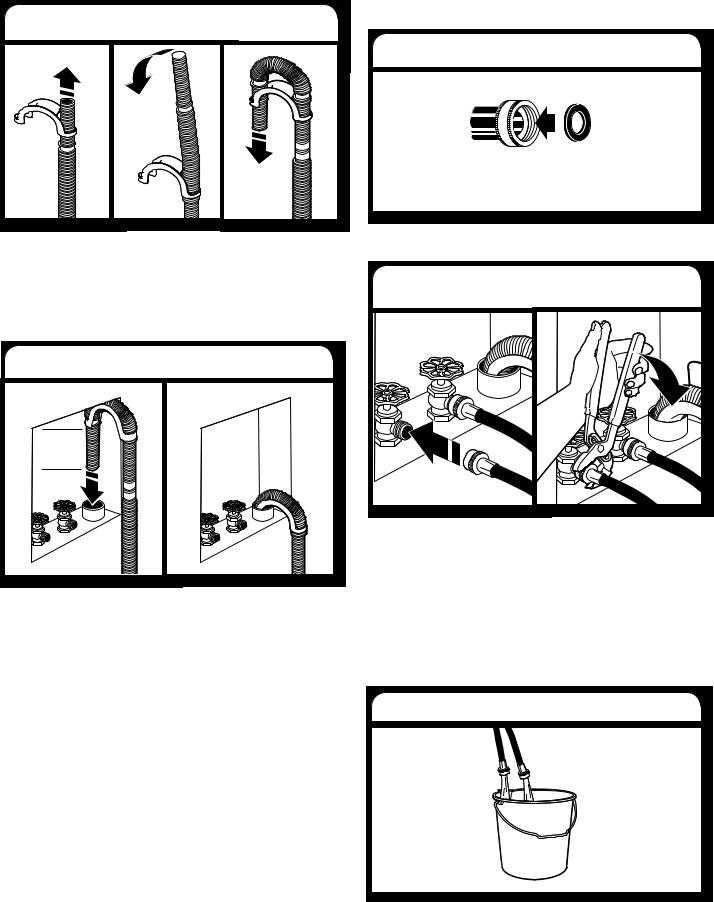
2. Connect drain hose form
For a laundry tub or standpipe drain, connect the drain hose form. For a floor drain, do not install drain hose form. You may need alternate parts with separate directions. See “Tools and Parts” to determine what you may need.
Feed hose into one end of form. Bend hose and feed through other side, anchoring form on smooth sections of hose. The hose must extend 4 1/2" (114 mm) beyond the form.
3. Place drain hose in standpipe
Connect Inlet Hoses
1. Insert new flat washers
A |
B |
A. Coupling |
|
B. Washer |
|
Insert new flat washers into each end of the inlet hoses. Firmly seat the washers in the couplings.
2. Connectfaucets inlet hoses to water
4.5" (113 mm)
Place hose into standpipe (shown in picture) or over side of laundry tub.
IMPORTANT: To keep drain water from going back into the washer:
■■ Do not force excess drain hose into standpipe. Hose should be secure but loose enough to provide a gap for air.
■■ Do not lay excess hose on the bottom of the laundry tub.
Make sure the washer basket is empty. Attach the hose labeled hot to hot water faucet. Screw on coupling by hand until it is seated on washer. Use pliers to tighten couplings an additional two-thirds turn. Repeat this step with the hose labeled cold for the cold water faucet. Both hoses must
be connected for washer to work properly.
IMPORTANT: Do not overtighten or use tape or sealants on valve when attaching to faucets or washer. Damage can result.
HELPFUL TIP: Make note of which hose is connected to hot water to help in attaching hoses to washer correctly.
3. Clear water lines
Run water for a few seconds through hoses into a laundry tub, drainpipe, or bucket to avoid clogs. Water should run until clear. Check the temperature of the water to make sure that the hot water hose is connected to the hot water faucet and the cold water hose is connected to the cold water faucet.
6
